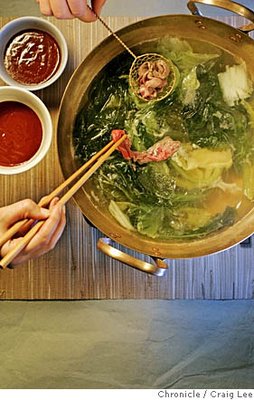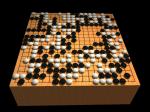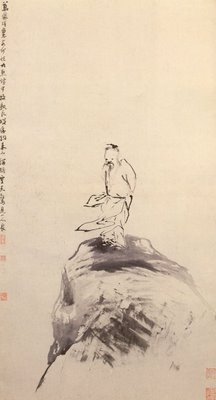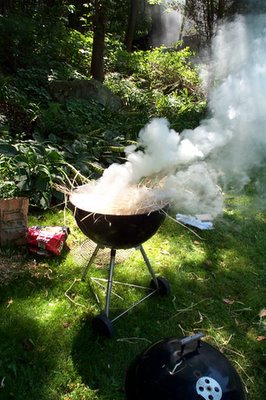 If you click on the title of this post, you'll be directed to the original newspaper article.HOT POT HEAVEN
If you click on the title of this post, you'll be directed to the original newspaper article.HOT POT HEAVEN The Chinese meal-in-a-pot is a great way to bring friends and family to the table for the new year
- Olivia Wu, Chronicle Staff Writer
Wednesday, December 28, 2005
The fire burns blue, the pot bubbles music and the steam swirls magical aromas.
Diners swish foods in a central cauldron for seconds, remove them and dunk them in a cooling sauce that's hot with chiles and garlic.
It's winter, time for the hot pot -- the easiest edible entertainment this side of popcorn. It's ideal for New Year's weekend, and a cinch for a celebration during the whole of winter.
Called huoguo in Mandarin, hot pot is the Chinese communal cook-your-own, gather-round-the-fire meal that is friendly in the extreme. It's like the fondue format on epic scale.
Hot pot has versions in Japan, where it is called shabu-shabu, all over Southeast Asia and even in Switzerland, where a butter-saturated version is called "fondue Chinoise."
Huoguo translates literally as fire (huo) and pot (guo), although it is also translated as steam pot or steam boat. With a heat source in the middle of the table, a pot of rich broth boiling and a dazzling array of meats, seafood, noodles and vegetables, this meal fills the belly and fuels the soul.
"The weather's turning cold, and people are starting to order the hot pot," says Vincent Kwang, manager of Millbrae's Hong Kong Flower Lounge, which lists this meal on its menu.
In Japanese, shabu-shabu refers to the sound a thin piece of meat makes as it is swished in broth. The same kind of language is employed in the Chinese regional variant called shuai yangrou, with the "shuai" meaning to rinse, for "rinsed lamb meat."
This version likely originated in traditionally Muslim Chinese areas, where lamb is cooked in a spicy, garlicky broth, but regional variations abound. In general, beef and lamb are used in the north and west parts of the country, while southern areas focus on seafood. In urban cosmopolitan centers, diners can order any combination of red meats, poultry and seafood, noodles and local greens.
Chinese and Japanese restaurants do a steamy trade in this meal. The large Chinese restaurants, usually the big dim sum specialists, pull it off easily. Millbrae's Hong Kong Flower Lounge makes hot pot available daily for $78 for four to six diners, and includes a large selection of seafood, says Kwang. Depending which raw foods are ordered, it costs from $15 to $20 per person. If diners order whole lobster and whole crab, says manager James Tam, the tab rises accordingly.
Koi Palace in Daly City has takers for the meal year-round for $26 per person.
In these restaurants, the Cantonese term is dabeen lo, which is almost untranslatable. A whimsical stab might be "Play-by-the-Stove.''
The name reflects the ease of setting up the meal. For many Asian families, it's the default winter celebration, especially for working moms and dads with abundant relatives; it feeds many with no cooking required.
For guests and family, it's a meal that engages everyone. How difficult is it to sit around a stove and cook delicious, healthful, fresh food? Following are the components you'll need; see recipes for cooking and serving instructions.
EQUIPMENT
Equipment can range from garage-sale vintage to glossy gourmet.
Following is what you need:
An electric frying pan is the central piece of hardware in Chinese student apartments, sometimes scavenged from yard sales, for just the purpose of hot pot. The pan is on the shallow side, but you don't need as much stock at the beginning -- just make sure to add more boiling stock or water often during the meal.
These days, electric woks would do just as well. You may graduate to restaurant style and purchase a tabletop propane stove -- the kind that some caterers use on buffet tables. In many Asian supermarkets, they can be found for as little as $14. However, it is better to find one with a high BTU.
You can place any attractive heatproof shallow pan on the tabletop burner. A bronze or copper wok is ideal.
Wooden chopsticks are perfect for quickly dipping raw foods in the broth. Guests who would be stressed by holding on with chopsticks can use little wire ladles (about 60 cents apiece).
A single 1-cup porcelain rice bowl per diner works best for the dipping sauce. By the end of the meal, it is used to hold a steaming serving of the scrumptious soup that contains the essence of all the foods cooked in it. You've never tasted a broth so rich.
MEAT AND FISH
Beef, lamb, pork, chicken, turkey, fin fish and shellfish can all be cooked in a hot pot. It's critical that you use absolutely the freshest products, cut as thinly as possible. Remember, the food cooks for just a few seconds.
The beef should be premium-quality beef, sliced extra-thin. Chinese and Japanese supermarkets offer a selection, ready sliced and packaged.
I prefer the Japanese supermarkets' shabu-shabu meats, which are film-thin. Ready-sliced sukiyaki beef will do in a pinch, but the slices are a little thicker.
At some markets, you can choose between premium varieties such as Angus, Wagyu and American kobe, all cut from the rib-eye. Pork sliced for shabu-shabu is often the highly flavorful Kurobuta.
The stores usually freeze a block of meat first, then machine-slice it. You can do the same at home if you choose to slice your own: Freeze the meat until just hard, then slice it into mere shavings.
Fish fillets should be cut on the diagonal into large, thin slices. Shrimp are peeled, deveined and halved lengthwise.
VEGETABLES
Napa cabbage, or da baicai , is the vegetable of choice because it is a winter vegetable. It should be cooked until tender and wilted, like warm sauerkraut.
Other leafy greens, such as spinach, also work well.
Soft tofu and quick-cooking noodles go into the rich broth at the end of the meal. Often, the host cooks these in bulk.
Cover the pot with a lid and allow the soup to come to a full boil. Then, with a "ta-da!", remove the lid and serve the hot rich soup with vegetables, tofu and noodles.
STOCK
A light chicken stock boosted with aromatic herbs such as ginger, green onions and pickled mustard is common.
Considering how much cooking goes on in the broth, it can begin as canned chicken broth diluted with water.
Make sure to have more stock or water simmering on the stove. Pour about 2 cups at a time into the hot pot as the stock evaporates during the dinner party. You may need to do this several times.
SAUCE
Many people buy bottled sauces, such as a Chinese barbecue sauce called "sacha sauce.'' Others dip into a simple soy-garlic-chile sauce. I've given the recipe for my family's classic, whipped up in minutes.
Hot Pot (Huoguo) Each person cooks and eats his or her own food. The best progression is to move from red meats to poultry to seafood.
INGREDIENTS:
6-8 ounces per person, assortment of raw, thin-sliced beef, pork, lamb, fish, cuttlefish, shrimp, poultry, all preferably prime or choice quality
1/2 to 1 pound soft or silken tofu
1 to 2 pounds napa cabbage, cut into 2-inch segments, stems and leaf separated
1 pound spinach, tender stems attached
4 ounces bean thread noodles, soaked and drained
Cooking broth:
About 2 quarts unsalted chicken stock + water to come within 1 1/2 inches of rim of pot
4 to 6 slices ginger
2 green onions
1 head cured mustard green (suancai)
Dipping sauce (see recipes)
Equipment:
1 to 1 1/2 gallon, 3- to 4-inch deep pot or wok, or 1 large electric fry pan or wok
1 tabletop burner (if not using electric appliance)
8- to 12-ounce soup or rice bowls, 1 per guest
Small plates, 1 per guest (optional)
Wire ladles, 1 per guest (optional)
Wooden chopsticks, 1 pair per guest
Soup spoons, 1 per guest
INSTRUCTIONS:
Place hot pot in the center of a table. Arrange the various meats attractively on serving plates and place around the hot pot. At each place setting, arrange a bowl, small plate (if using), soup spoon, chopstick and wire ladle.
Invite each guest to spoon about 2 tablespoons of the sauce in his/her bowl. A sprinkle of cilantro and/or green onion over the sauce is optional. Those who have a more timid palate should use only about 1 tablespoon of the sauce.
Bring the soup broth ingredients to a boil and cook for about 30 minutes. If using a burner/pot equipment, it is usually faster to cook it on the stove at a rolling boil before bringing the pan out to the propane stove.
Using the wire ladle or chopsticks to hold the raw food, dunk it in the boiling soup and hold it there until done. Do not overcook, especially the beef or lamb. Some prefer these meats medium rare, which means cooking them a few seconds, "rinsing" them in the broth. Remove and release into the prepared bowl, dipping it lightly in the sauce. Have boiling water on hand to replenish the liquid as it boils down.
The covered, slow-cooking segment begins when everyone has had their fill of meat and fish.
The host adds the cabbage stem segments, covers the pot and allows it to boil for about 10 minutes.
Add tofu, the cabbage leaves, spinach and bean thread noodles and bring broth to a boil, letting it cook for another 5 minutes. Serve broth, vegetables, tofu and noodles into the sauce bowls.
There should be just enough sauce left to season the broth. Those who want more can use more sauce. This soup -- with all the vegetables and noodles, which absorb all the flavors of the meats -- is the grand finale of the meal.
Serves 8
PER SERVING: 395 calories, 56 g protein, 15 g carbohydrate, 12 g fat (4 g saturated), 105 mg cholesterol, 500 mg sodium, 4 g fiber.
Rich Hot Pot Sauce INGREDIENTS:1/4-1/3 cup kojojang (Korean red pepper miso) or substitute 1/4 cup chile garlic bean paste
2 cloves garlic (if not using chile garlic bean paste)
2 squares of brined tofu (doufu-ru), optional
3 tablespoons Chinese sesame paste (not tahini)
2 tablespoons light (not lite) soy sauce
2 tablespoons rice vinegar
1 tablespoon sugar
1/2 cup vegetable oil
1/4 cup Shaoxing (rice) wine or sake
3 tablespoons imported, roasted sesame oil
1-2 tablespoons water
1 cup chopped cilantro
1 cup minced green onion
INSTRUCTIONS:
Place ingredients up to sesame oil in a food processor or blender and process until smooth.
Slowly add water as the machine runs until you have the consistency of a thin mayonnaise. You may also add water if the flavors are too strong. To adjust seasonings, add sugar if the sauce is too spicy and sesame paste if too salty.
Each hot pot diner should take about 2 tablespoons in his/her bowl. The use of the paste varies enormously. Those who like intense flavors can go through 4 or 6 tablespoons. Others are satisfied by just 1 tablespoon. Sprinkle with cilantro and onion, as desired.
Yields 1 1/2 cups
PER TABLESPOON: 70 calories, 1 g protein, 2 g carbohydrate, 7 g fat (1 g saturated), 0 cholesterol, 184 mg sodium, 0 fiber.
Simple Hot Pot Sauce INGREDIENTS:
2 tablespoons soy sauce (Kikkoman)
1/2- 3/4 teaspoon sugar
1 teaspoon rice vinegar
1/2 teaspoon imported sesame oil
Hot sauce, such as chile garlic bean paste, to taste, optional
INSTRUCTIONS:
Stir together ingredients until sugar is dissolved. Dip meats in sauce as they are cooked and removed from the hot pot.
Serves 2
PER TABLESPOON 24 calories, 1 g protein, 3 g carbohydrate, 1 g fat (0 saturated), 0 cholesterol, 1,029 mg sodium, 0 fiber.
Analysis is for the dipping sauce provided per person. The amount consumed will vary.
E-mail Olivia Wu at
http://us.f524.mail.yahoo.com/ym/Compose?To=owu@sfchronicle.com.





















